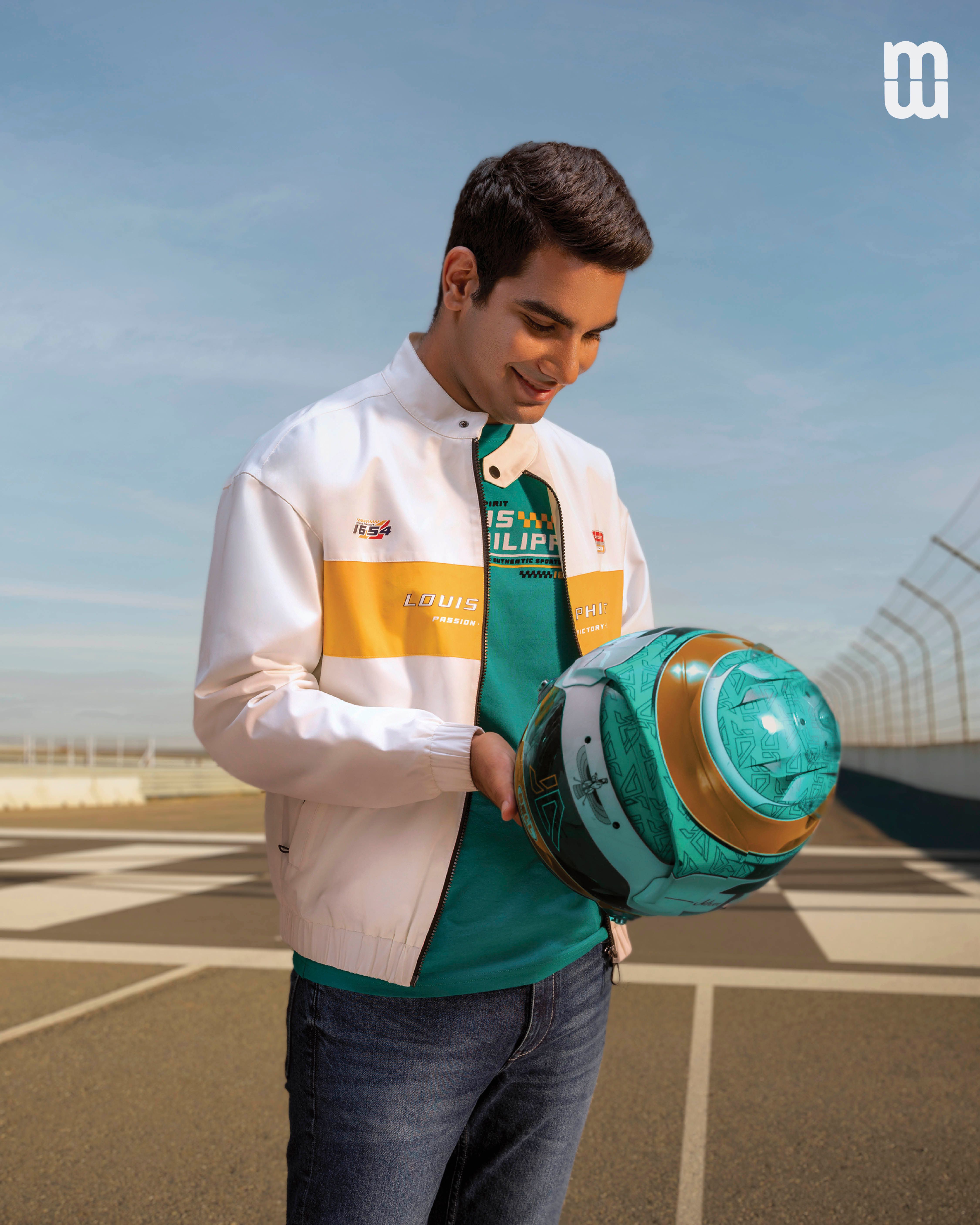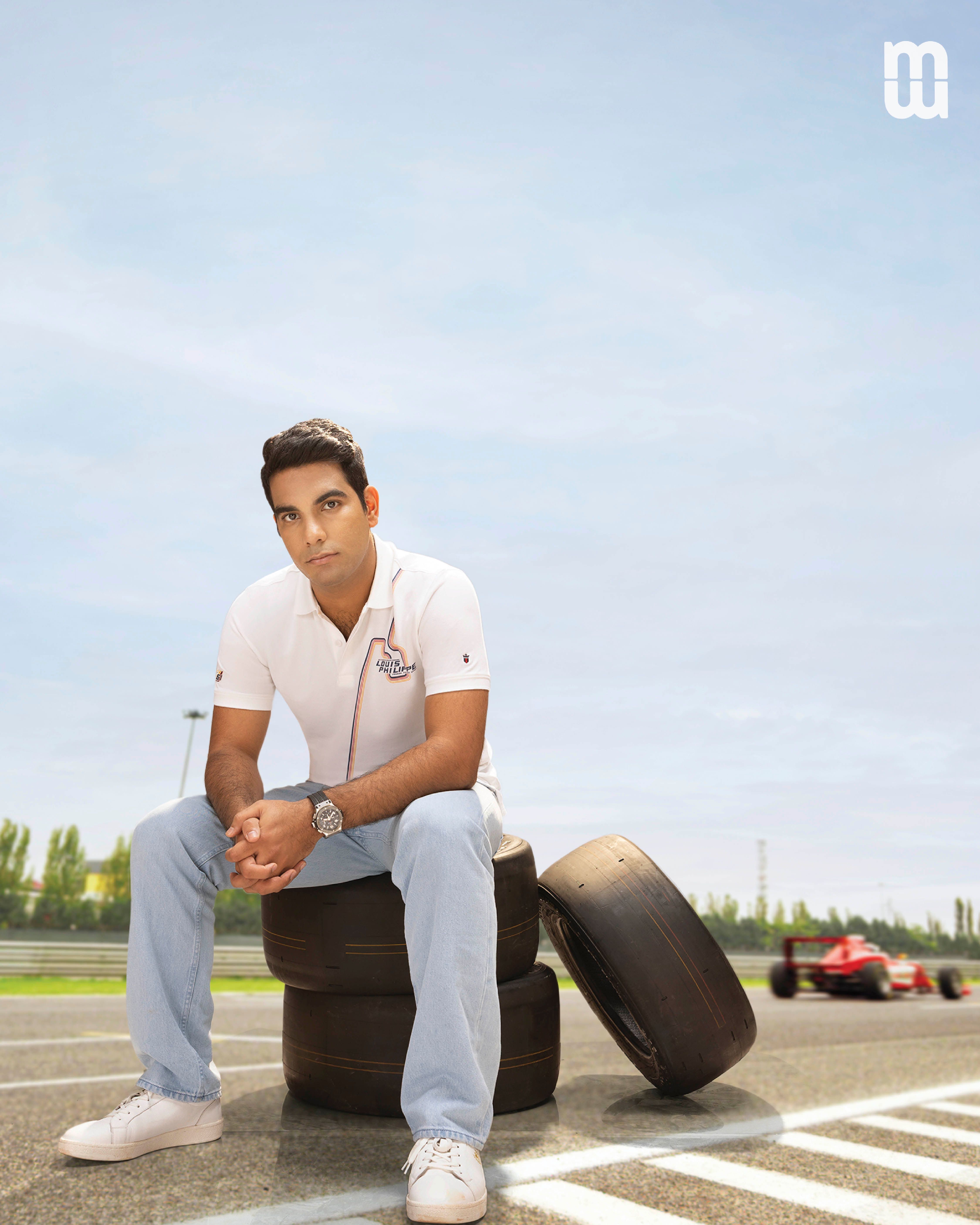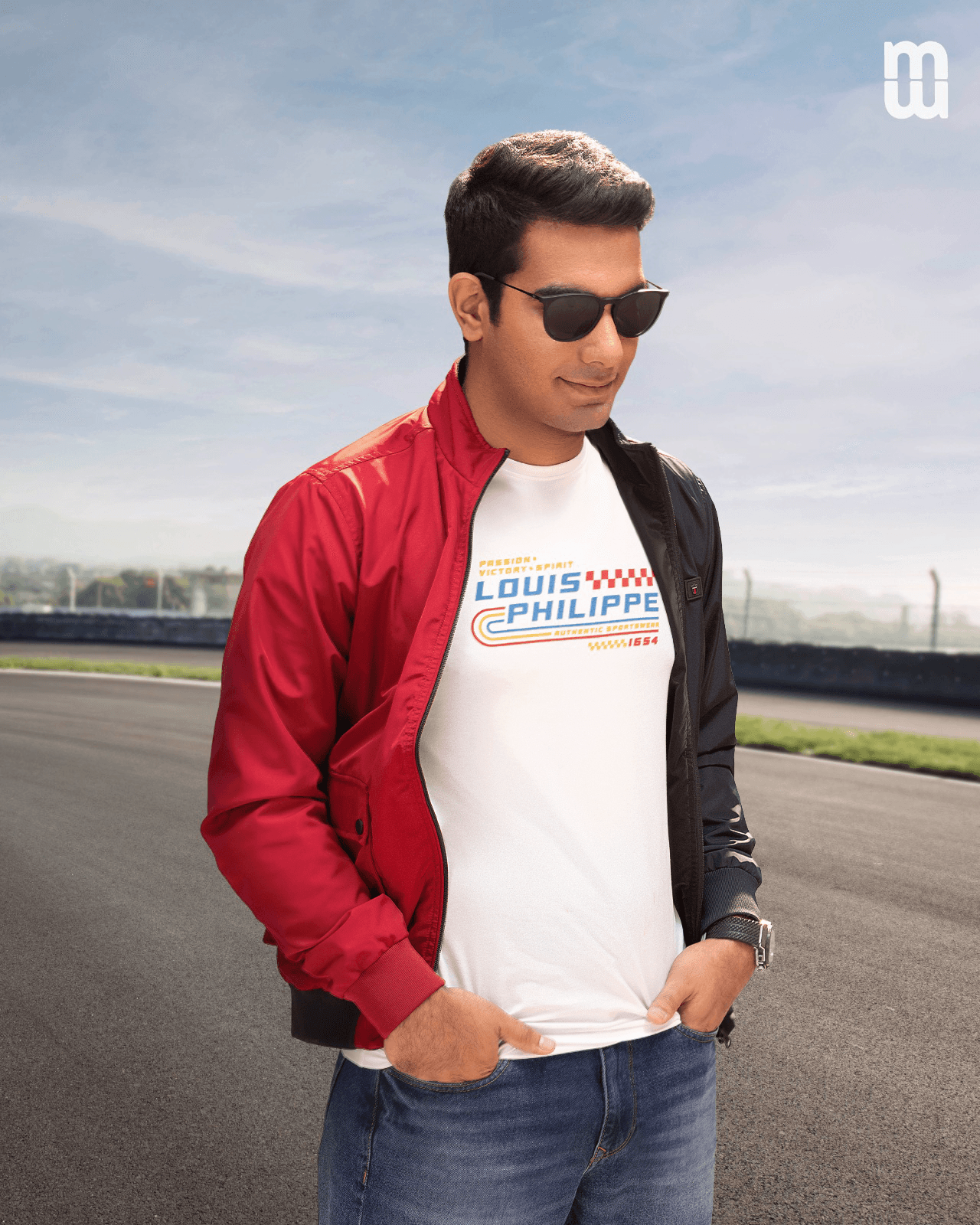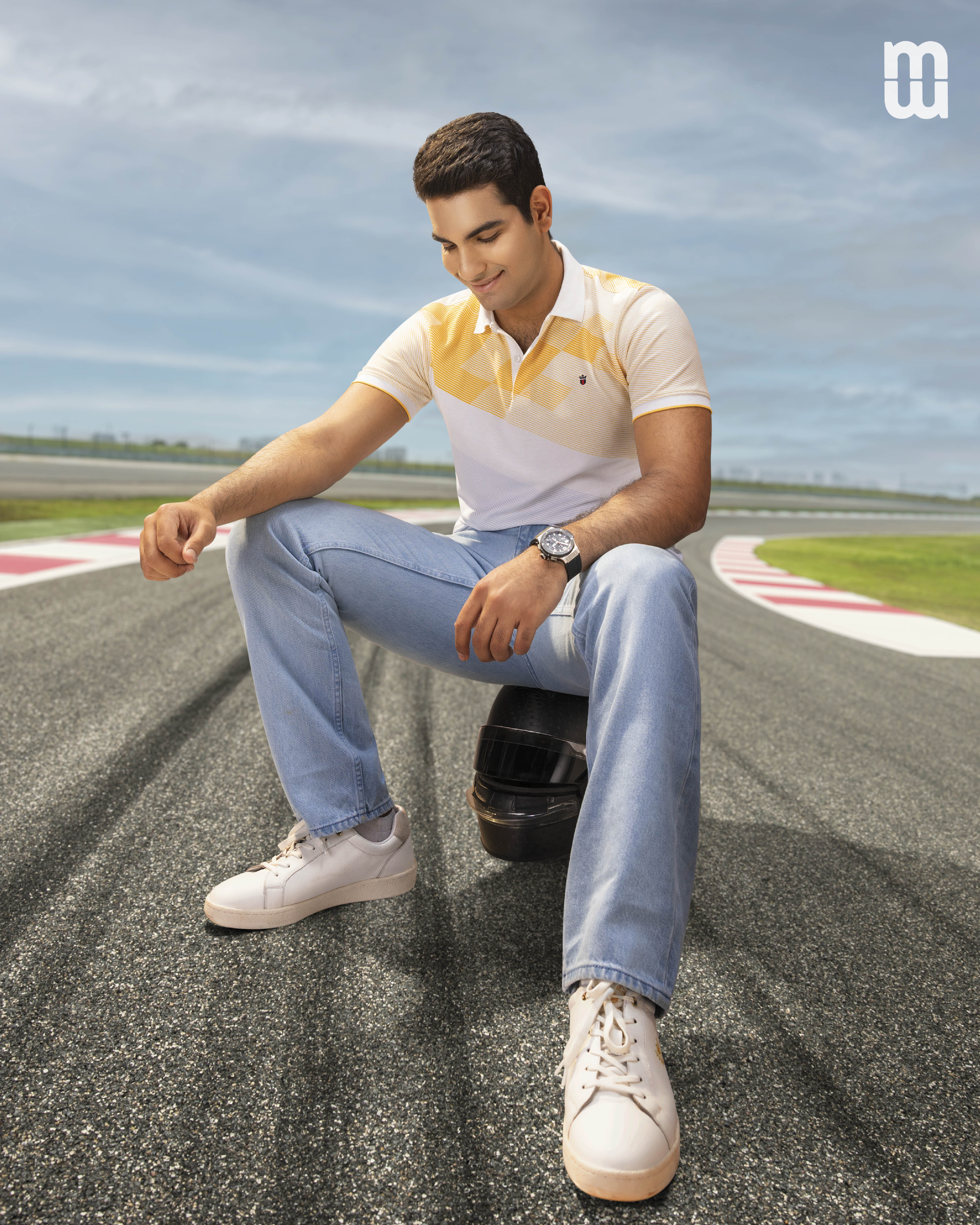The studio is in controlled chaos. Cables snake across the floor like rogue track lines. Light stands are shuffled into new positions every few minutes. There's a low buzz of art direction chatter, camera clicks, and someone frantically trying to just find some coffee. And then, like a well-timed pit stop, Jehan Daruvala walks in — calm, quiet, and composed. He’s dressed in a simple denim and t-shirt, carrying two helmets that feel like talismans from two very different lives.
The first is instantly arresting: a striking saffron, white and green design with the ancient Zoroastrian Faravahar etched proudly at the back, his name inscribed in a sharp script on the side. It’s personal, patriotic, powerful. The second helmet is sleeker, stripped back — carbon fibre with minimal detailing and maximum cool.
Jehan hands them over with a faint, polite smile and surveys the swarm of assistants, stylists, and creative crew with a mix of curiosity and discomfort. He’s not in his natural habitat. “Maia made this look so easy,” he says with a laugh, referring to his fiancée, Maia Shroff, an entrepreneur who runs her own swimwear label and has had her fair share of experience on shoots. “Honestly, it’s a lot harder than it looks.”

That’s a sentence that holds true for Jehan’s story — the reality of what it takes beneath the surface. Born in Mumbai to a Parsi family on October 1, 1998, Jehan’s childhood wasn’t steeped in motorsport legacy, but his fascination with speed began early by watching Formula 1 races with his family as a kid. His father, Khurshed (MD at Sterling & Wilson, a Shapoorji Pallonji Group affiliate firm) had dabbled in karting too, but it was Jehan who pursued the motorsport dream relentlessly. By age nine, he had started karting in India, training under champion Rayomand Banajee, an eight-time formula, go-karting champion and owner of Rayo Racing.
His talent was unmistakable. After dominating local competitions and winning the Asia-Pacific Karting title in 2012, he became the first Indian to win an FIA Championship in karting. Soon after, he earned a place in Force India’s “One in a Billion” program, which launched his international career. From there, he moved to Europe and quickly ascended through the junior ranks, racing in Formula Renault, the Toyota Racing Series (where he finished just behind Lando Norris), and then GP3 and FIA Formula 3.
Jehan’s performance in these intensely competitive series earned him the attention of Helmut Marko, who offered him a coveted spot in the Red Bull Junior Program, where he trained alongside future F1 stars and held his own. Over the years, he shared the grid and garage with some of the sport’s finest — including Lando Norris, now competing for the 2025 F1 title, and Yuki Tsunoda, who currently races for RB in F1. Jehan was often their equal in pace, and at times, their superior in results.
He graduated to FIA Formula 2 in 2020, spending four full seasons on the international circuit. In that time, he raced with top-tier teams like Carlin and Prema, notched multiple podiums, and made history by becoming the first Indian to win a Formula 2 race — at the Sakhir sprint race in Bahrain in 2020, followed by a race victory at Monza in 2022. He finished 12th in his rookie season, and seventh overall in both 2021 and 2022, outpacing nearly every other Indian driver to ever compete at this level. Among his peers, Kush Maini is the only other Indian currently active in F2, but Jehan remains the more decorated of the two, with multiple wins and four seasons under his belt.
At the end of November 2022, Daruvala was announced as a test and reserve driver for Mahindra Racing in Formula E for the 2022-23 season debuting. And in 2024, he signed a contract with Maserati MSG Racing. However, after numerous reliability issues, Daruvala’s rookie season in Formula E ended with him finishing 21st in the standings and announced that he wouldn’t be returning for the next season. As of now, Jehan is on a hiatus from racing. While he figures out what’s next for him on track, he’s taking this break to reset mentally, reflect on career direction, and prioritise personal life i.e. getting married to his girlfriend of 10 years.
His future in motorsports stands uncertain today. But his motorsport dreams are still alive and kicking. He’s already tested F1 cars with McLaren — a feat no other Indian has achieved in recent years — and while a race seat may be elusive, a test or reserve role is still within reach. Historically, no Indian has yet graduated directly from F2 to an F1 race seat, though Karun Chandhok raced in GP2 (F2’s predecessor) and Narain Karthikeyan moved into F1 from other series, not via modern F2.
What makes Jehan’s journey truly extraordinary, though, is the context he’s risen from. India’s motorsport culture is still in its infancy. Formula 1 pulled out of the country after just three years. MotoGP suspended its India race after just one event. And yet, there are glimmers of change — the introduction of the FIA-certified Indian F4 Championship, albeit across just three circuits, shows promise. Teams are now Indian-owned. The structure is beginning to take shape. But even in this changing landscape, Jehan remains an outlier — a product of relentless will, not systemised support.

For our digital cover shoot, Jehan wears pieces from Louis Philippe’s Race Day Revival, a capsule collection that pays tribute to the very world he represents. The fact that a major Indian fashion house continues to invest in a racing-themed line is telling of the fact that there’s a growing appetite for motorsport in India, and Jehan Daruvala is one of the rare figures driving it forward, both literally and culturally.
The Interview:
Q: What drew you to motorsports first and what made you realise you wanted to pursue motorsports professionally?
Honestly, ever since I was a young boy, I used to love speed. As a kid, me and my family would sit and watch racing together every race weekend. So, it was really exciting for me. I started racing professionally when I was nine. I started with go-karts because I had a real, real love for racing and that’s how my career really began.
Q: What are some lessons you learnt in your karting career that helped you when you started competing internationally?
I learned a lot in my karting career that helped me when I moved into racing cars. When I first went to Europe, I realised how difficult the competition was. There are a hundred drivers in karting and you are all competing for one thing, which is to win. So you can imagine that it's rare. You don't always win. You learn to take setbacks, you have to keep working hard. Every weekend is difficult, and there's actually more failure than success in racing. Those lessons have taken me a long way and helped me gain the ability to bounce back, analyse, study them and always try to come back stronger.
Q: How different is motorsports at the grassroots in India, when compared to the global scene?
Motorsport in India is very different to Europe. I raced in India for a couple of years before racing across different venues in Asia and then Europe. It's just that a lot more people are doing it out there. In India, if you are half a second off the person who's first, you still qualify in the top five. While in Europe, if you’re half a second off, you don't qualify in the top 50. That just shows how difficult the competition is out there. And that's why when I first went there, it was a huge shock. It was ultra, ultra competitive. People out there have been karting since they were four years old, and that's considered normal. I started karting when I was nine.
Q: You’ve raced in F2 and Formula E. How do the driving styles and strategies differ across these formats?
Yeah, there's definitely a bit of a difference in Formula Two and Formula E. Honestly, in qualifying, there is a smaller difference. As drivers, we’re just pushing the car to the maximum. In general, the cars in Formula E have less downforce. They probably have a similar amount of power now and way more acceleration. So there's less grip for the amount of power we have in Formula E, but it makes it very fun to drive. The races are different. In Formula E, we have to manage battery percentage and energy, while in Formula Two we have to manage tires more. Those are the key differences between the two.

Q. Can you talk us through one of your most memorable races and wins? What are some of your most favourite and least favourite tracks?
My most memorable race win would be at the end of 2020 in Bahrain. My first win in Formula Two and it came after a little bit of a difficult season, and to finish it off with a win and have the national anthem play in Bahrain, which is such a prestigious stage, meant a lot to me. I'll never forget it. It's always been a great memory and will always be my favourite victory.
Talking about racetracks, my favourite track would be Spa in Belgium. I always had a lot of fun there. It's also the longest track on the calendar. But my least favourite is a track called Paul Ricard in France. Even though I had success there, I've just not enjoyed the layout as much as I do on other tracks.
Q: What was it like to drive alongside current F1 drivers like Lando Norris and Yuki Tsunoda, among others? Are you still friends?
I've had the privilege, yes, to be teammates with people like Yuki Tsunoda and Lando Norris across my time. I would say, Lando has definitely been the most talented teammate I've ever had. He was my teammate in karting, in Formula Three as well. And yeah, we are still friends till date and I wish him all the best and hopefully he becomes a World Champion at the end of this year.
Q: How did you become a Red Bull junior driver in 2020? Did you have any interactions with Helmut Marko or Christian Horner?
Yes, in 2019, I wasn't associated with any academy but had a great season in Formula Three. I was fighting for the championship at that time when I was part of Prema. Dr. Helmut Marko saw some good potential in me and he approached us at the end of the year in Sochi in Russia at the last race. We spoke, and he asked me if I wanted to join the Red Bull Academy. That's where it all started.
Yes, I've had interactions with Christian Horner and Helmut Marko as well. And it is a known fact that the Red Bull Academy is harsh. But they say it how it is, which is good for us drivers. They’re very honest. They tell us where we need to get better and if we want to go to Formula One, the goals are clearly defined.
Q: How do you mentally prepare before a race weekend? And what do you do to stay fit off the track?
To mentally prepare for a weekend, I have a mind coach that I used to always speak to. We had a good relationship. It helped me talk about things and open up about where I can improve. It was a routine that I followed.
On the physical side, as everyone knows, car racing is super physical. There's a lot of G-force. The main training really comes for the neck. It's very difficult to train your neck. So we work on it at least two, three days a week. Apart from that, mainly cardio and lifting weights. Midseason, it’s difficult because we have a lot of racing and practice, so it’s always tough to balance rest and gym time.

Q: Motorsports wasn’t mainstream when you started. How did you get not just your family and friends but also sponsors to believe in your dream?
My family has been a huge support for me. I remember telling my parents when I was 10 years old that I wanted to make racing my career, and they've been supportive all along the way. Luckily, financially, we were able to afford it. It is a well-known fact that racing is a very, very expensive sport. Unfortunately, even to this day in India, sponsorship is very, very difficult. Even after all the success I've had along the way, it's still tough to attract sponsors. It continues to be difficult to this day.
Q. Motorsports are steadily gaining more attention in India, due to the increasing popularity of F1. Do you think young Indian drivers today have a better shot internationally compared to when you started?
I don't think that it has changed much in India compared to Europe in the last many years. When you grow up in Europe, you have access to great infrastructure, great competition. While in India, it's still very limited. So, I don't believe the chances of an Indian making it to Formula One are more than they used to be. But it definitely helps that more kids are watching F1 and more children have started go-karting. Still, the chances of making it into Formula One are very, very difficult. It's a combination of a lot of factors, and everything has to go your way to reach the top.
Q. We saw you racing for Maserati in Formula E last. What’s next on the cards for you?
Yes. Last year was my debut season in Formula E, driving for Maserati Racing. It was great to drive in Formula E. It was not an easy season, but I learned a lot along the way.
To drive for such a brand was great for me. Currently, I'm not doing anything this year. I've taken a year off. It was difficult to find a seat anyway, so I'm still seeing what plans I have for next year. As of now, I've been spending time with my dad in the family business — and that's about it so far.
Q. You’re getting married soon. How are you prepping for it? What’s it like to juggle a relationship with your busy schedule and travel when you’re competing?
Even though it sounds difficult, it hasn't been in our case. Maia has really taken charge of all the wedding planning, so we've been lucky with that. Our relationship has been super great over the past 10 years. In terms of juggling my relationship with my schedule and my travel, it's actually been very easy. In the past couple of years, we've even travelled together a lot. She's come for a lot of my races and been a great support to me the entire time.
Q. What does an off day look like for you?
Time off for me is typically spending some time at my farmhouse, just completely switching off, being around friends and family, and really relaxing… doing nothing and just being with nature.
Q. How would you describe your style, off the track?
My style off track, I would say, is pretty casual. I just like plain, comfortable clothes. But what I would say is, I'm definitely better styled when I'm around my fiancée.

Q. When you look back at your journey so far… the highs, the setbacks, the sacrifices… what do you hope your legacy will be, both as a racer and as a person?
I definitely feel proud of my career. I feel like I've been one of the most successful Indians ever in the junior single-seater ladder, going all the way up to Formula Two.
More than that, honestly, I feel like I've made great friends along the way. I've met great people. And more importantly, I think I'm just happy with the person I turned out to be. You know, that's one of the most important things… to be a good person… and that, among everything else, will take you a long way in life.
Credits:
Wardrobe Courtesy: Louis Philippe
Text: Vrutika Shah
Photographer: Rohit Gupta
Sr. Art Director: Hemali Limbachiya
Stylist: The Pêche Stylists (Peusha Sethia & Sakshi Prithyani)
Hairstylist & Make-Up: Hardeep Arora (@hardeeparora12)
Artist Reputation Management: Meraki Sport and Entertainment
Tyre Courtesy: JK Tyre






